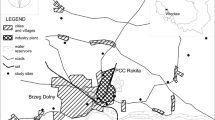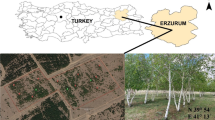Abstract
Chromium, copper, cadmium, lead, nickel, iron and zinc contents of a lichen species (Pyxine subcinerea Stirton) and mango bark collected from 12 sites in Haridwar city (Uttarakhand) were compared with soil, sampled from beneath the tree from which lichens were collected. The metal contents in lichen, bark and soil ranged from 1,573 to 18,793, 256 to 590 and 684 to 801 μg g−1, respectively. This clearly indicates that lichens accumulated higher amounts of metal compared to bark or soil. Statistical analysis revealed that metal concentration in lichens did not show significant linear correlation with the bark or soil. Pearsons correlation coefficients revealed negative correlation of Pb (r = −0.2245) and Ni (r = −0.0480) content between lichen and soil, which indicate direct atmospheric input of metals from ambient environment. Quantification and comparison of elemental concentration in lichens, its substratum and soil can provide valuable information about air quality in the collection area.




Similar content being viewed by others
References
Baker DA (1983) Uptake of cations and their transport within the plants. In: Robb DA, Pierpoint WS (eds) Metals and micronutrients: uptake and utilization by plants. Academic Press, London, pp 3–19
Bjerke JW (2011) Winter climate change: ice encapsulation at mild subfreezing temperatures kills freeze-tolerant lichens. Environ Exp Bot 72:404–408
Chauhan A, Pawar M, Kumar R, Joshi PC (2010) Ambient air quality status in Uttarakhand (India): a case study of Haridwar and Dehradun using air quality index. J Am Sci 6(9):565–574
Chettri MK, Sawidis T, Karataglis S (1997) Lichens as a tool for biogeochemical prospecting. Ecotoxicol Environ Saf 38:322–335
Crespo A, Divakar PK, Argüello A, Gasca C, Hawksworth DL (2004) Molecular studies on Punctelia species of the Iberian Peninsula, with an emphasis on specimens newly colonizing Madrid. The Lichenologist 36:299–308
Garty J, Tomer S, Levin T, Lehra H (2003) Lichens as biomonitors around a coal-fired power station in Israel. Environ Res 91:186–198
Goyal R, Seaward MRD (1982) Metal uptake in terricolous lichens. II. Translocation in the thallus of Peltigera canina. New Phytol 90:85–98
Green T, Sancho L, Türk R, Seppelt R, Hogg I (2011) High diversity of lichens at 84°S, Queen Maud Mountains, suggests preglacial survival of species in the Ross Sea region, Antarctica. Polar Biol 34:1211–1220
Hardiman RT, Jacoby B (1984) Absorption and translocation of Cd in bush beans (Phaseolus vulgaris). Physiol Plant 61:670–674
Hawksworth DL, McManus PM (1989) Lichen recolonization in London under conditions of rapidly falling sulphur dioxide, and the concept of zone skipping. J Linn Soc Bot 100:99–109
Kannan K (1997) Fundamentals of Environmental Pollution. S. Chand and Co. Ltd, New Delhi
Lodenius M, Kiiskinen J, Tulisalo E (2010) Metal levels in an epiphytic lichen as indicators of air quality in a suburb of Helsinki, Finland. Boreal Environ Res 15:446–452
Loppi S, Frati L (2006) Lichen diversity and lichen transplants as monitors of air pollution in a rural area of central Italy. Environ Monit Assess 114:361–375
Loppi S, Pacioni G, Olivieri N, Di Giacomo F (1998) Accumulation of trace metals in the lichen Evernia prunasteri transplanted at biomonitoring sites in Central Italy. Bryologist 101(3):451–454
Loppi S, Pirintsos SA, Dominics V (1999) Soil contribution to the elemental composition of epiphytic lichens (Tuscany, Central Italy). Environ Monit Assess 58:121–131
Markert BA, Breure AM, Zechmeister HG (2003) Definitions, strategies and principles for bioindication/biomonitoring of the environment. In: Markert BA, Breure AM, Zechmeister HG (eds) Bioindicators and biomonitors. Elsevier, Oxford, pp 3–39
McCune B (2000) Lichen communities as indicators of forest health. The Bryologist 103:353–356
Nieboer E, Richardson DHS (1981) Lichens as monitors of atmospheric deposition. In: Eisenreich SJ (ed) Atmospheric inputs of pollutants to natural waters. An Arbor Science Publishing, Michigan, pp 339–388
Nimis PL, Scheidegger C, Wolseley P (2002) Monitoring with lichens—monitoring lichens. Kluwer Academics, Dordrecht
Ormrod DP (1984) Impact of trace element pollution on plant species. In: Treshow M (ed) Air pollution and plant life. Wiley & Sons, New York, pp 291–319
Paoli L, Loppi S (2008) A biological method to monitor early effect of the air pollution. Environ Pollut 155:383–388
Pfeiffer HN, Barclay-Estrup P (1992) The use of a single lichen species, Hypogymnia physodes as an indicator of air quality in Northwestern Ontario. Bryologist 95:38–41
Pinho P, Augusto S, Branquinho C, Bio A, Pereira MJ, Soares A, Catarino F (2004) Mapping lichen diversity as a first step for air quality assessment. J Atm Chem 49:377–389
Pirintsos SA, Matsi T, Vokou D, Gaggi C, Loppi S (2006) Vertical distribution patterns of trace elements in an urban environment as reflected by their accumulation in lichen transplant. J Atmos Chem 54:121–131
Purvis OW, Dubbin W, Chimonides PDJ, Jones GC, Read H (2008) The multielement content of the lichen Parmelia sulcata, soil, and oak bark in relation to acidification and climate. Sci Total Environ 390:558–568
Rani M, Shukla V, Upreti DK, Rajwar GS (2011) Periodical monitoring with lichen, Phaeophyscia hispidula (Ach.) Moberg in Dehradun city, Uttarakhand, India. Environmentalist 31:376–381
Sadiq M, Alam I, El-Mubarek A, Al-Mohdar HM (1989) Preliminary evaluation of metal pollution from wear of auto tires. Bull Environ Contam Toxicol 42:743–748
Shukla V, Upreti DK (2007a) Physiological response of the lichen Phaeophyscia hispidula (Ach.) Essl. to the urban environment of Pauri and Srinagar (Garhwal), Himalayas. Environ Pollut 150:295–299
Shukla V, Upreti DK (2007b) Heavy metal accumulation in Phaeophyscia hispidula en route to Badrinath, Uttaranchal, India. Environ Monit Assess 131:365–369
Shukla V, Upreti DK (2008) Effect of metallic pollutants on the physiology of lichen, Pyxine subcinerea Stirton in Garhwal Himalayas. Environ Monit Assess 141:237–243
Shukla V, Upreti DK, Patel DK, Tripathi R (2010) Accumulation of polycyclic aromatic hydrocarbons in some lichens of Garhwal Himalayas, India. Int J Environ Waste Manag 5(1/2):104–113
Shukla V, Patel DK, Upreti DK, Yunus M (2011) Lichens to distinguish urban from industrial PAHs. Environ Chem Lett. doi:10.1007/s10311-011-0336-0
St. Clair BS, St. Clair LL, Weber JD, Mangelson FN, Eggett LD (2002) Element accumulation patterns in foliose and fruticose lichens from rock and bark substrates in Arizona. The Bryologist 105:415–421
Streit B, Stumm W (1993) Chemical properties of metals and the process of bioaccumulation in terrestrial plants. In: Markert B (ed) Plants as Biomonitors. VCH, Weinheim, pp 31–62
Thormann MN (2006) Lichens as indicators of forest health in Canada. The Forestry Chronicle 82(3):335–343
Tuba Z, Csintalan Z (1993) Bioindication of road motor traffic caused heavy metal pollution by lichen transplants. In: Markert B (ed) Plants as biomonitors Indicators for heavy metal in the terrestrial environment. VCH, Weinheim, pp 329–341
Ward NI (1989) Multielement contamination of British motorway environments. In: Vernet JP (ed) Heavy metals in the environment. International conference, vol II, Geneva. CEP Consultant, Edinburgh, pp 279–282
Wolterbeek HTh, Garty J, Reis MA, Freitas MC (2003) Biomonitors in use: lichens and metal air pollution. In: Breure AM, Zechmeister HG, Markert BA (eds) Bioindicators and biomonitors. Elsevier, Oxford, pp 377–419
Acknowledgments
Authors (M.Y. and V.S.) are thankful to the Vice Chancellor, Babasaheb Bhimrao Ambedkar (Central) University, Lucknow for providing Laboratory facilities. V.S. wishes to thanks Scientific and Engineering Research Council Division, Department of Science and Technology, New Delhi (SR/FT/LS-028/2008) for the financial support. Authors wish to thank Dr. Sudhir Shukla for statistical analysis of the data and Ms Anu Rastogi for valuable help.
Author information
Authors and Affiliations
Corresponding author
Rights and permissions
About this article
Cite this article
Shukla, V., Patel, D.K., Upreti, D.K. et al. A comparison of metallic contents in lichen Pyxine subcinerea, its substratum and soil. Int. J. Environ. Sci. Technol. 10, 37–46 (2013). https://doi.org/10.1007/s13762-012-0075-1
Received:
Revised:
Accepted:
Published:
Issue Date:
DOI: https://doi.org/10.1007/s13762-012-0075-1




